Important Potato Diseases and Pests
![]()
Diseases
Bacterial Ring Rot
Impact
Bacterial ring rot (BRR) is caused by the bacterium Clavibacter michiganensis subsp. sepedonicus. BRR is a serious disease of potato. Presence in seed will result in rejection of lots for certification. The bacteria overwinter mainly in infected seed tubers. BRR is capable of surviving more than five years in dried slime on the surfaces of crates, bins, burlap sacks, and harvesting and grading machinery. Survival is possible even if exposed to temperatures well below 0 degree F. BRR survives longest under cool, dry conditions. BRR occurs sporadically in the San Luis Valley and other areas where use of certified potato seed is common..
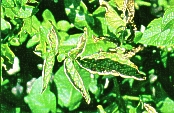 |
 |
| BRR Foliar Symptoms | BRR Tuber Symptoms |
Description and Symptoms
Foliar symptoms usually appear late in the growing season. Cultivars differ greatly in their expression of the disease. Symptoms include: early dwarfing, rosetting of upper leaves and general wilting of the plant with chlorosis and necrosis of the leaves. Stems of plants, when cut at the base, produce a milky exudate upon squeezing. Commonly, only one or two stems develop symptoms. Infected tubers often develop a creamy yellow to light brown rot in the vascular ring. BRR readily spreads between tubers during seed cutting and handling. Tubers and plants may be symptomless even though they are infected with BRR.
Integrated Management
Plant certified seed potatoes. Never plant contaminated seed lots. Avoid cutting seed tubers and using pick-type planters. Maintain strict sanitation aimed at eliminating BRR from all production surfaces. A complete sanitation program involves thoroughly washing all surfaces with a detergent applied by a high-pressure washer, rinsing with clean water and sanitizing with a suitable disinfectant for a minimum of 10 minutes under ideal conditions. Undertake a thorough cleanup and sanitation of any farm with confirmed BRR in potato stocks to reduce risk of carryover into next year's crop. Dispose of infected tubers and cull piles as soon as possible. Salvage a commercial crop with a low level of BRR by an integrated management approach involving delayed harvest, careful grading to remove any decayed tubers when the crop is placed in storage, and proper storage management. Do not save seed to replant. Market potatoes as soon as possible. No resistant cultivars and pesticide control are available.
Seed Piece Decay and Blackleg Plant
Impact
The causal agent is Erwinia carotovora subspp. carotovora and atroseptica. Occurrence of these diseases is influenced by seasonal environment. The San Luis Valley certified seed industry strives to minimize outbreaks by using tissue-culture derived stocks coupled with a limited generation system and a complete disease testing program.
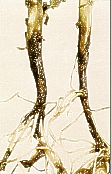
Description and Symptoms
Bacteria are carried on seed tubers, mainly in the lenticels, in a dormant state. When environmental conditions are favorable, disease expression may occur. High soil temperatures and bruising of seed tubers, or cool, wet and poorly aerated soils at planting, favor seed piece decay and pre-emergence blackleg. Cool, wet soils at planting, followed by high temperatures after emergence, favor post-emergence blackleg. Fusarium seed piece decay may predispose developing plants to infection by the soft rot Erwinias, resulting in increased soft rot of seed pieces and early-season blackleg. In severe cases, entire seed pieces and developing sprouts decay prior to emergence, resulting in uneven stands. In post-emergence blackleg, the basal stem area of diseased plants typically exhibit an inky black to light brown decay.
Integrated Management
Conduct a thorough sanitation program throughout the entire farming operation. No resistant cultivars are available. However, cultivars vary in susceptibility to the disease. No pesticide control is available. Plant high quality, tissue-culture derived, certified seed to minimize seed- borne contamination. Plant undamaged, whole seed tubers that are less susceptible to bacterial seed piece decay. When cut seed is used, thoroughly clean all seed-cutting and handling equipment between seed lots to minimize the spread of bacteria. Warm seed tubers to about 45 to 55 degrees F before cutting. Wound healing and suberization are critical for prevention of infections by soft rot Erwinias. Plant seed pieces in adequate soil moisture when temperatures are at least 50 degrees F at a 6-inch depth.
Impact
Fusarium dry rot is caused by several common species of the soil borne fungus Fusarium. Fusarium dry rot causes losses in storage of both seed and commercial potatoes. It is a potential cause of seed piece decay after planting. Disease incidence varies from season to season in the San Luis Valley.
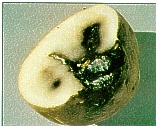
Description and Symptoms
Small, brown lesions at wound sites occur three to four weeks after harvest and continue to enlarge during storage. Infected areas of tubers are sunken or wrinkled. Rotted tissues are brown or gray to black. Internal cavities often develop in rotted tissues and contain white, yellow or pink mycelium that are visible when tubers are cut. At low storage temperatures, internal tissues often become firm and dry or even powdery. Infection proceeds rapidly at temperatures above 50 degrees F, but ceases and is dormant if the temperature is lowered to 40 degrees F. Poor stands may result from seed piece decay, especially if the cut surfaces of the seed pieces are not properly suberized. A slimy rot often develops when secondary soft rot bacteria become established.
Integrated Management
Manage harvest procedures and storage operations to minimize bruising and to promote rapid healing of harvest wounds. Apply fungicides to tubers that will be stored if Fusarium dry rot is anticipated. Manage bin filling to minimize soil and debris in the pile. Hold newly harvested potatoes at 50 to 60 degrees F and 95 to 99 percent relative humidity to promote rapid wound healing. Following the curing period, lower temperatures to a level appropriate for long-term storage. Treat cut seed tubers with a fungicide, if justified. Plant immediately under appropriate field conditions, or allow to suberize at 55 to 60 degrees F and 95 to 99 percent relative humidity for at least 72 hours. Avoid cutting seed tubers and the use of pick-type planters.
For More Information on Late Blight Click here.
Impact
Late blight is caused by the fungus Phytophthora infestans. Late blight is one of the most devastating diseases of potato worldwide. This disease is most serious where the weather is consistently cool and humid. In recent years, epidemics of late blight have developed in crops under center-pivot irrigation in and production areas.
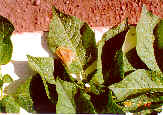 |
 |
| Late Blight Foliar Lesions | Late Blight Tuber Symptoms |
Description and Symptoms
Symptoms of late blight appear on leaves as pale-green, water-soaked spots, usually beginning at the leaf tips or edges. The circular or irregularly shaped lesions are often surrounded by a pale, yellowish-green border. The lesions enlarge rapidly and turn brown or purplish black. During periods of high relative humidity and leaf wetness, lesions may be bordered by a cotton-like white mold growth on the underside of the leaf. In dry weather, infected leaf tissues turn brown and quickly dry up. Infected stems and petioles turn brown to black, and entire vines may be killed. Under cool, moist conditions, the fungus can form spores on the foliage of infected plants. These spores are easily dislodged and can be moved by the wind into neighboring potato fields and cause new infections. On the tuber surface, lesions appear brown and sunken while tissues immediately beneath appear granular and tan to copper-brown. The fungus survives between crops in infected tubers. Tubers removed during grading and dumped in cull piles or unharvested tubers in the fields or rock piles are sources of the pathogen. Newer strains of the fungus are more aggressive, resulting in a higher incidence of tuber infection. Infection can occur on other Solanaceous species such as pepper, tomatoes and various nightshade species.
Integrated Management
Plant disease free on drop seed. Scout fields weekly after emergence until harvest. Apply fungicides to all fields starting before rows close. Continue applications at recommended intervals for the remainder of the season. There are late blight forcasting models that can predict when late blight may get aggressive. You can save a lot on early fungicides using these models as well as know better when to get serious about fungicide applications. One model is included in the University of Wisconsin's WISDOM program. Colorado State University has an interactive version of this Blitecast model that uses Colorado weather information. Click here to go to that site. Complete coverage of all foliage with a fungicide is essential. Ground application is most effective. Fungicide applications should continue until vines are dead. Harvest only after vines are completely dead. Handle tubers gently to avoid mechanical damage and to reduce the risk of infection. Avoid harvesting under wet conditions. If wet tubers are harvested, steps must be taken to remove free moisture from their surfaces quickly. Dispose of cull piles promptly. The fungicide program to prevent late blight is expensive, but costs can be contained with planning. Click here for some late blight prevention program budget and schedule options.
For more information on Early Blight click here
Impact
Early blight is caused by the fungus Alternaria solani. Foliar infections can greatly reduce leaf area, limiting tuber yields. Early blight is a common and economically serious disease that occurs annually in the San Luis Valley.
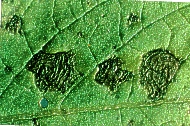 |
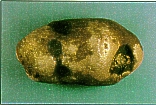 |
| Early Blight Lesion with Concentric Rings Pattern | Early Blight Tuber Symptoms |
Description and Symptoms
Leaf lesions are circular and dark with a yellow border. As lesions expand, an angular appearance develops due to confinement by the leaf veins. Target-like or concentric rings of raised and lowered dead tissue are typical in large lesions. Infection usually begins on older, lower leaves and moves slowly into the upper canopy. Tubers are infected at harvest by fungal spores present on the soil surface. Tuber lesions are circular to irregular-shaped, slightly sunken and dark- colored with a raised purple to brown border. Tuber tissue under the lesion is dark and dry, appearing corky or leathery. After extended storage of infected tubers, moisture loss from the lesions can result in shriveling. Early blight spores overwinter in soil, crop residue and on infected tubers.
Integrated Management
Manage the crop for optimal crop fertility and soil moisture to slow disease development. Scout for foliar lesions at emergence and continue weekly. Monitor degree-day reports provided by Colorado State University Cooperative Extension to determine timing of fungicide application. Apply fungicides uniformly to the plant canopy. Fungicides are not available to treat tuber infection on commercial potatoes. Minimize tuber injuries to limit tuber infection. Proper skin set is the most important barrier to infection. Cool storages rapidly if tuber infections are anticipated. Keep in mind conditions favoring suberization also favor tuber blight development. Manage storage to avoid free water on structural surfaces.
Impact
Silver scurf, caused by the fungus Helminthosporium solani, is a common disease in most potato producing areas. Silver scurf can drastically lower market quality of tubers. This disease is difficult to manage. As a result of imported seed, silver scurf has become a more important disease Use high-quality, certified seed.
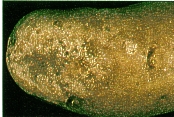
Description and Symptoms
Spread of the fungus to daughter tubers is largely from infected seed pieces; soil transmission also is a factor. Infections become more severe the longer the tubers remain in the soil. Infections occur in the field as tubers mature. Symptoms may be present on tubers at harvest or may develop on tubers in storage. Infected areas have a distinct silvery sheen, particularly if the surface is wet. Infected tubers will shrivel during storage from excessive water loss. High humidity and temperatures above 40 degrees F foster silver scurf development in storage. Tuber to tuber spread in storage is common.
Integrated Management
Use high-quality, certified seed. Note: this practice will not offer 100 percent control. Harvest as soon as adequate skin set has been achieved. Ventilate storage areas with cool air for drying. Store tubers at the lowest possible temperature consistent with the intended end use. No pesticides are presently available for effective control. Rotate crops and potato cultivars.
Impact
Pink rot is caused by the soil borne fungus Phytophthora erythroseptica. Pythium leak is caused by several species of a closely related soil borne fungus Pythium. Pink rot and Pythium leak sometimes are collectively called water rot or leak. These diseases usually are of economic concern when tubers are exposed to saturated soils for several days in succession during maturation and soil temperatures are above 70 F. Leak and pink rot in susceptible cultivars are most severe in the San Luis Valley when warm, wet conditions prevail late in the growing season.
 |
 |
| Pink Rot | Pythium Leak |
Description and Symptoms
Pink Rot
The pathogen can enter tubers through diseased stolons. Tuber infections also occur at eyes and lenticels. The decay spreads through infected tubers quickly. The advancing margin of the rot is sharply defined by a dark line, which may be visible through the skin. Decaying tubers remain intact, are spongy and have a distinct odor. If squeezed, a clear liquid exudes. The internal tissue of a cut tuber turns salmon pink after exposure to the air for 15 to 20 minutes then turns brownish black.
Pythium Leak
Tuber wounds during harvest and handling are the main infection sites for Pythium. The disease begins as a discolored, water-soaked area. As with pink rot, the advancing margin of the rot usually is bound by a dark line. The most characteristic tuber symptom is an extremely watery condition of diseased Tissues, which turn brown or gray.
Integrated Management
Rotate crops out of potatoes for at least four years to reduce Phytophthora and Pythium levels in the soil. Select well-drained fields and avoid excessive irrigation in the weeks prior to harvesting highly susceptible cultivars. Apply a systemic fungicide on susceptible cultivars when a field has a do history of pink rot. Delay harvest when pulp temperatures are above 70 degrees F. Pick up windrowed tubers quickly and tarp loads to avoid overheating during warm harvest conditions. Store diseased lots separately from healthy lots. Keep temperatures below 45 degrees F. Provide good air flow to dry and cool infected tubers. Market diseased lots quickly or directly from the field. If considerable pink rot is present in the field, delay harvest to allow the full development of symptoms in infected tubers so they can be graded out before the crop is placed in storage. Rule of thumb is if more than 5 % of tubers going into storage have disease and rot, you won't be able to store that lot.
Impact
Potato early dying is predominantly caused by the soilborne fungus Verticillium dahliae. Interactions with lesion nematodes can significantly increase the incidence and severity of early dying. Strains of lesion nematodes vary considerable in their virulence in this interaction with verticillium. The disease is characterized by premature vine death and declining yields. Fields continuously cropped with potatoes are common sites of the disease. Potato early dying is rarely a problem in the San Luis Valley due to the cool environmental conditions and short growing seasons.
Description and Symptoms
Symptoms of potato early dying are difficult to distinguish from normal senescence. Infected plants may only initially exhibit retarded growth. Foliar symptoms appear as uneven chlorosis and some wilting of the lower leaves. Areas between leaf veins turn yellow and later brown, often at the leaf tip first. Leaf yellowing and death proceed up the stem, which usually remains erect. A tan discoloration of the vascular tissues usually can be seen when a stem is cut in a cross section near its base. Non-infested fields can become contaminated with Verticillium carried in or on the surface of seed tubers or in soil particles transported by the wind or by mechanical means. Once established in a field, the fungus will persist in the soil for several years. Verticillium can be maintained at a low population in the roots of many symptomless crop and weed species. High populations of the root-lesion nematode, Pratylenchus spp., in the presence of Verticillium can increase potato early dying .
Integrated Management
Rotate out of potatoes for two or three years. Maximize yields by maintaining optimum fertility and providing adequate soil moisture to overcome the effects of Verticillium wilt in the field. Plant resistant cultivars. This is the most practical method for management of potato early dying. However, availability of resistant cultivars is limited. Avoid highly susceptible varieties which can increase the levels of Verticillium in the soil and result in higher soil inoculum levels. Apply soil fumigants to reduce populations of Verticillium. Fumigants do not completely eradicate the pathogen from infested fields. However, fumigation in the San Luis Valley appears to have long-term effects. Due to the high cost, base the decision to fumigate on the field history of early dying, cultivar to be grown, and on an assay of the soil to determine nematode and Verticillium populations. In some growing areas fumigants are used commonly. Use of certain cover crops like sudan grass, rapeseed and some radishes has had some benefit in reducing early dying problems.
Impact
Potato leafroll is caused by the potato leafroll virus. The severity of symptoms depends on the strain of virus, susceptibility of the cultivar, time of infection, and environment. Yield may be substantially reduced in plants grown from infected tubers. Potato leafroll severity has been reduced in the San Luis Valley as a result of a comprehensive aphid suppression and monitoring program.
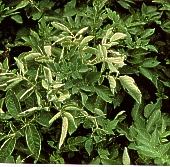
Description and Symptoms
Leafroll is introduced by planting infected seed or by aphids carrying the virus to the field from an outside source. Leafroll is transmitted by several species of aphids. The green peach aphid is, the primary vector in the San Luis Valley and other areas. Aphids acquire the virus after several hours of feeding and require an incubation period before being able to transmit the virus to non-infected plants. Once infected, the aphid usually retains the virus for life. Lower leaves of plants grown from leafroll-infected seed tubers become rolled and leathery and may turn light pink or yellow. Infected plants usually are stunted and more upright than healthy plants. Young leaves may become. yellow or slightly pinkish and rolled and may stand upright in early current-season infections. Current-season infections that develop late in the season may cause no visible symptoms, but tubers usually become infected. Early season infections may reduce yield.
Integrated Management
Plant high quality, certified seed. Check the weekly San Luis Valley green peach aphid monitoring reports at the San Luis Valley Research Center and scout your fields regulary for green peach aphids.. Control aphid populations in the field, and on other hosts. Rogue infected plants early in the season to control disease sources in the field. Consider early vine-kill when high aphid populations are present.
Economic thresholds for control:
| Aphids found in 100 sweeps with a
sweep net
(Make sure you sweep lower leaves of plant) |
Control point for common seed | Control point for high generation seed |
| Green Peach Aphid levels | 5 aphids | 1 aphid |
| Potato Aphid Levels | 20 aphids | 10 aphids |
Impact
Two potato mosaic viruses that are important in the San Luis Valley are Potato Virus X (PVX) and Potato Virus Y (PVY). PVX is known as potato latent virus disease, potato mottle or latent mosaic. PVY causes severe or rugose mosaic. PVY is reported to cause losses ranging from 10 to 80 percent, depending on the potato cultivar. The primary effect of both viruses is a reduction in yield and size of daughter tubers. The Colorado seed certification program minimizes the impact of these viruses in the San Luis Valley by conducting an extensive testing program.
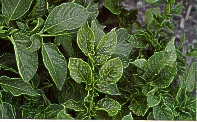
Description and Symptoms
PVX
PVX usually causes few or no symptoms in most cultivars and can be carried in seed stocks unnoticed. PVX is readily transmitted mechanically. It is spread by foliar or sprout contact, seed cutters, pick-type planters, cultivators, spray equipment, and possibly by insects with chewing mouthparts. Some strains alone, or in combination with PVY, may cause rugose mosaic.
PVY
PVY is a stylet-borne virus transmitted by at least 30 species of aphids, particularly the green peach aphid and potato aphids. Cereal aphids in high numbers become important vectors of PVY Symptoms of PVY may vary by cultivar. Necrosis and veinal necrosis of petioles often cause leaves to drop or cling to the stems. Infected plants have bunchy tops and leafless lower stems or clinging necrotic leaves. In Russet Norkotah, visible symptoms do not become well developed. Aphids landing on infected plants acquire PVY within a few seconds of feeding and can transmit the virus immediately, in a non-persistent manner. While aphid transmission is the most important means of spread in the field, all PVY strains also are mechanically transmissible by leaf contact and may be carried in seed tubers. Current-season infection late in the growing season may not cause foliar symptoms.
Integrated Management
Plant high quality, pathogen tested, certified seed. Conduct a strict sanitation program including use of detergents. Destroy volunteer potatoes which may harbor PVX or PVY. Avoid cutting seed that is extensively sprouted. Complete cultivation, hilling, and other post emergence operations when plants are less than 6 to 8 inches tall. Control of aphids is an important component of a management program for viruses. However, this action will not control PVY. Kill vines early to avoid late season aphid flights. Use of pesticides is not an effective control measure since many vectoring aphids are not specific to potatoes and move though a field quickly and infection if aphids with PVX and PVY is casual. Use of trap crops around fields can offer some control. Take advantage of beneficial insects.
Impact
Rhizoctonia canker and black scurf are caused by the soilborne fungus Rhizoctonia solaiii. The fungus survives in soil as mycelium associated with decomposing plant residues. In addition, the sclerotia can survive on infected tubers and can persist free in soils for extended periods. Rhizoctonia is sporadic throughout the San Luis Valley depending on environmental conditions.

Description and Symptoms
Brownish black, sunken lesions on underground stems and stolons are characteristic of Rhizoctonia canker. The disease may cause nonuniform stands and weak, spindly looking or late-emerging plants. Sprouts attacked before emergence are often killed, which leads to delayed emergence by weaker sprouts. Infected sprouts that do emerge, often remain stunted. Early-season infections frequently result in pruning of young stolons. Cool, moist soils, 55 degrees to 60 degrees F, are optimal for infection. Deep, sunken cankers may girdle main stems, causing yellowing, purpling, upward curling of leaves, and the formation of aerial tubers. These symptoms can be confused with symptoms of other diseases. The fungus forms individual sclerotia or masses of sclerotia on mature tubers, referred to as black scurf. Appearance varies from dark, netted or scurfy residues on tuber surfaces to individual black masses ranging from pinhead to pea-size.
Integrated Management
Rhizoctonia stem canker. Use high quality certified seed with low levels of Rhizoctonia black scurf, because tuber-borne inoculum is most likely to result in serious sprout infection. Rotate out of potatoes preferably to a small grain, to slow fungal population development. Plant early to limit stem infection. Since potato stems are much less susceptible to attack by Rhizoctonia after green tissue develops following emergence, any practice favoring rapid emergence is useful in disease management. These practices include planting in warm soil above 60 degrees F, warming seed tubers before planting and pre-irrigation of dry soil. Cover seed pieces with 4 to 6 inches of soil at planting. If problems with Rhizoctonia canker are anticipated, knock down hills earlier to encourage faster seedling growth. Avoid excess early season irrigations. Minimize sprout damage during cultivation to limit increased stem infection. Harvest tubers in a timely fashion, after vine desiccation and death, to limit the development of sclerotia on tuber surfaces.
Colorado Potato Beetle
Impact
The Colorado Potato Beetle (CPB) is the most common and potentially destructive pest of potatoes in many parts of the U.S. Curiously it is not found in the San Luis valley of Colorado. It can completely defoliate plants if not controlled.

Description and Symptoms
Adult beetles have stout, oval bodies with distinctive yellow-orange coloration and narrow black stripes on the wing covers. The beetles overwinter as adults burrowed deeply in the soil. They emerge in May and lay bright yellow eggs on the undersides of potato plant leaves. The eggs hatch in 4 to 16 days depending on the temperature. There are four larva instar stages. First instar larva are bright red, and latter stages are light orange. The larva pupate in the soil. Second and latter generation adults feed much more than overwintering adults and are responsible for the extensive foliar damage.
Integrated Management
Scout fields for egg masses in May. Scout adults and larva using a sweep net. Identify larva by instar. Small larva are much more sensitive to insecticides. Head size is a much more accurate way to determine instar level. Crop rotation is the major non-chemical control method because it reduces and delays infestations in the spring. The reduction and delay effect is very important. Natural predators are usually not effective. Several pesticides are labeled for CPB control, but the CPB is very effective in developing resistence to pesticides. CPB has developed resistence to every pesticide on the market. Resistant varieties (Bt) has afforded excellent control lately. Eggs are not susceptible to control so wait for larva to hatch. Insecticides should only be applied when thresholds are exceeded. Failure to achieve a high level of control of the first generation larva can result in more seasonal problems. Rotation of pesticides is important. Discontinue use of a pesticide if control fails. Degree day models can be used to predict CPB growth stages.
Temperature and Growth Stages
| Average Temperature
(degrees F) |
Time for eggs to hatch (days) | Time from egg hatch to 3rd Instar (days) | Time for total Larva
Stage
(days) |
Time for Pupation (days) |
| 60 | 12 - 16 | 11- -19 | 31 - 35 | none |
| 68 | 7 - 8 | 7 - 9 | 15 - 20 | 16 - 20 |
| 75 | 4 - 5 | 5 - 7 | 10 - 15 | 10 - 13 |
| 84 | 3 - 4 | 3 - 6 | 8 - 11 | 7 - 10 |
Allowable Defoliation of Potato Plants Without Yield Reduction
| Plant Size | Allowable Defoliation |
| 6 to 8 inches | 20 - 30 % |
| Flowering | 5 - 10 % |
| Tuber Formation | 30 % |
Impact
The primary aphid species found on potatoes in the San Luis Valley are the green peach aphid, Myzus persicae, and the potato aphid, Macrosiphum euphorbiae. Aphids transmit virus diseases, notably Potato Virus Y (PVY) and Potato Leafroll Virus (PLRV). The green peach aphid is the most efficient vector of PLRV to potato; potato aphid is less efficient but may be important in some locations and seasons. Many other aphid species transmit PVY. Significant direct injury from aphid feeding rarely occurs, except during extreme outbreaks. The San Luis Valley has a comprehensive aphid suppression and monitoring program to control green peach aphid populations which occur annually. Populations vary in intensity depending on environmental conditions.
 |
 |
 |
| Green Peach Aphid Adults and Nymphs | Potato Aphid Nymphs | Green Peach Aphid (Top) and Potato Aphid (Bottom) Identification Guide |
Description and Symptoms
Wingless green peach aphids tend to be pear shaped. They may have variable colors but usually are straw-colored or light-green. Hind cornicles slant so they converge. A key characteristic is tubercles at the base of the antennae. Potato aphids are more elongate and larger, about 1/6 to 1/8 inch, than the green peach aphid. They often are bright green, but pinkish forms occur. They are similar in general appearance to the English grain aphid. Both potato and green peach aphids produce winged forms. Winged aphids are most important in spread of viruses to plants since they move readily within and between fields. Wingless green peach aphids tend to occur on lower, older potato leaves. Potato aphids more commonly colonize the upper part of the potato plant. During the summer, aphids reproduce asexually (no males) and give live birth to young. Under optimal conditions, a generation may be completed in 10 days. Several predators and parasites help control aphids. Among the more important insects are lady beetles, damsel bugs, green lacewings, minute pirate, and parasitic wasps. Green peach aphids overwinter in the egg stage on various Prunus species, particularly plum and apricot, in and around towns. It may also be introduced on infested greenhouse plants. Potato aphid overwinters in the San Luis Valley on wild rose.
Integrated Management
Monitor flights of winged aphids by using yellow traps (yellow dishpans with water and a bit of bleach) and follow the weekly San Luis Valley monitoring reports. Sweep fields at least weekly to monitor aphids . Make sure to get the sweep net deep in the canopy since a lot of aphids are found on lower leaves. Pull up yellowish plants to check for aphid colonies. Apply pesticides only when necessary. Use of some insecticides can exacerbate aphid problems, because the control has more effect on natural enemies than on aphids. Insecticides can only provide limited control of aphid transmitted virus diseases. The green peach aphid can be highly resistant to insecticides registered on potatoes. Therefore, choose insecticides carefully for effective control. Protect natural predator populations that are important in aphid management. Trap crops around the edges of fields can help aphid control. Below is a table of threshold levels for control measures if seed is to be saved form a potato field. Direct damage from aphid feeding in a strictly commercial field needs high populations. If aphid levels are approaching 50 aphids per plant, treat the field.
Threshold levels
| Aphids found in 100 sweeps with a
sweep net
(Make sure you sweep lower leaves of plant) |
Control point for common seed | Control point for high generation seed |
| Green Peach Aphid levels | 5 aphids | 1 aphid |
| Potato Aphid Levels | 20 aphids | 10 aphids |
Impact
The aster or six-spotted leafhopper, Macrosteles quadrilineatus, does not injure the plant directly. However, certain phytoplasma-like potato disease agents are transmitted by this insect pest in the San Luis Valley. The potato leafhopper has not been found in the San Luis Valley. It is found in other areas and can cause serious damage to potatoes. Potato leafhoppers feeding on potatoes can cause hopper burn -- a yellowing of leaf margins, sometimes leading to necrotic areas with a down-turning of leaf. Severe potato leafhopper feeding can significantly reduce yield. The inter-mountain potato leafhopper, which produces small flecking wounds on leaves, may also occur.
 |
 |
 |
| Aster Leafhopper | Potato Leafhopper | Leafhopper Identification Guide |
Description and Symptoms
Leafhoppers are elongated, wedge-shaped insects, broadest in the head and thoracic regions and tapering along their wings. They are strong fliers and may migrate long distances. The aster leafhopper's body is dull light green and may appear silvery gray when wings are folded at rest. Six distinct spots occur on the top of the head. The aster leafhopper is the principal vector of aster yellows or purple top, a disease caused by a bacteria (phytoplasm). Adults are best sampled by sweep net, and nymphs by examining randomly picked midplant leaves. Nymphs are rarely seen on potatoes in the San Luis Valley. Several leafhoppers occur in the San Luis Valley, most of which are harmless to potatoes. Potato leafhoppers have a long and narrow body, are a bright lime green color and have white spots on their heads. Potato leafhopper nymphs are characterized by their side-wise crab-like movement.
Integrated Management
Scout by taking 100 sweeps across two rows with a net 15 inches in diameter. Check for the presence of adult leafhoppers, which transmit disease organisms. Apply pesticides only to control large infestations which rarely occur. Pesticide application is only economically viable on seed potatoes in most situations except in the case of potato leafhoppers which can damage the current season's crop.
Threshold Levels
| Leafhopper | Threshold for control | Threshold for Concern |
| Potato Leaf hopper | 1.5 adults/sweep | 0.5 to 1.0 adults per sweep |
| Aster Leafhopper | 1 to 2 adults per sweep | 0.5 adults per sweep |
Potato Psyllid
Impact
The potato psyllid overwinters in the southern region of North America. Infestations that develop in the San Luis Valley originate each year from winged migrants moving in from overwintering areas along the border of the United States and Mexico. Economically significant outbreaks of potato psyllid are uncommon in the San Luis Valley and are dependent on large migrations that occur approximately once every five years.
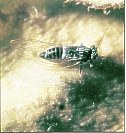 |
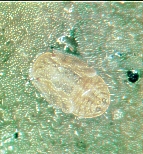 |
| Psyllid Adult | Psyllid Nymph |
Description and Symptoms
The adult psyllid resembles a tiny cicada and is about 1/8 inch long. The nymphs are flattened, scalelike and pale yellow-green. Damage is caused by nymphs that inject a toxin while feeding. The toxin induces a condition known as psyllid yellows. Feeding by adult psyllids has little or no effect on potato yields at any time. As few as three or four psyllid nymphs per plant can produce psyllid yellows on pre-bloom plants under favorable conditions. Immature leaves on infested plants turn red or purple and are abnormally erect, with the basal portion cupped. Older leaves become unusually thick, roll upward and turn yellow. Internodes become shortened. Affected plants produce aerial tubers and excessive numbers of small, distorted tubers, which may sprout without a dormant period. Skin set can also be affected in tubers from infested plants. Yield effects occur when plants become infested early in the season.
Integrated Management
Scout for psyllids before initiating control measures. Increase scouting for nymphs seven to 10 days after finding adult populations. Nymphs are most frequently found on plants exhibiting psyllid yellows. Some varieties attract more psyllids than others like Russet Nugget. Scouting for nymphs should concentrate on the lower leaves of early planted potatoes. Examine 50 leaflets randomly selected throughout the field. Potato psyllid can be difficult to scout on potato plants, since populations tend to occur in patches on lower, shaded leaves. Within fields, adult psyllids, but not immature nymphs, are best sampled with a sweep net. Apply insecticides whenever nymphs can be easily detected in fields. Treat if more than four to eight adults are captured per 100 sweeps and nymphs are detected in fields. Protect natural enemy populations by avoiding use of insecticides that adversely affect psyllid predators. Some insecticides (Sevin, Furadan) may aggravate psyllid problems because of effects on their predators.
Impact
Potato tuberworm (Phthorimaea operculella) is a worldwide pest of stored potatoes. It is a very devastating pest in many warm areas of the world. It is not found in the San Luis Valley of Colorado.
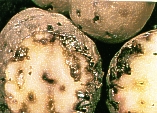
Description and Symptoms
The tuberworm is a small caterpillar, the larva of a inconspicuous gray and black moth called the potato tubermoth. The larva is usually dull white with a brown head. The tuber worm can have several generations a year in warm areas. Tuberworms also feed on other solaneceae species like nightshade, tomato and eggplant. On potato tubers the larva feed just below the surface and sometimes deep into the flesh. The tubers can appear black since the tuberworm tunnels are filled with larval feces. In any case tuberworm feeding leaves the tuber un-marketable. Tuberworms will feed on the tubers, but they prefer the tubers. Varieties that have tubers well protected by soil can tolerate higher populations of tuberworms.
Integrated Management
Pheromones are available to monitor the tubermoth populations. The trap consists of a dishpan of water with a little soap to break the surface tension of the water. Place a tent over the trap to help catch adult moths and place the pheromone inside to attract them. If you catch 10 - 20 per day you should treat the field. Pesticide treatment must occur before vine kill. Planting varieties that set tubers deep in the soil and hilling the plants up well to protect the tubers from tuberworm can help reduce damage.
Impact
Wire worms feed directly on the tubers. Infestations are spotty, but they tend to occur in the same areas form year to year. Damage can be very significant in these areas leaving many tubers un-marketable.

Description and Symptoms
Wire worms resemble the mealworms sold in pet stores as feed. They are slender, long, yellowish to brown larva with a smooth but tough skin. The brown to black beetle adults are know as click beetles since they can flip themselves over with a audible click. Most of their life is spent in larval form -- it takes 3 - 4 years to complete their life cycle. Larva feed on plant roots as well as tubers.
Integrated Management
Since wire worms have such a long life-span, field records are useful in determining control options. Wireworm populations build up in cereal and alfalfa crops. Wireworm populations can be monitored by baiting before a potato crop is planted. Place a piece of carrot 3 inches deep in various places in the field. Another bait is some flour wrapped up in netting. Baiting is not effective if the soil is too cold, wet, or has too mush residue. It may be difficult to find patches of wireworm in a field. Pesticide control is either at planting or before potatoes emerge.
Lygus Bug and False ChinchBug
Impact
Lygus bugs, Lyglis elisus and Lygus hesperus, are general feeders found on most plants and trees. False chinch bugs, Nysus spp., may mass in large numbers feeding on a wide range of plant hosts. Seldom do these insects threaten San Luis Valley potatoes. However, isolated problems may prompt consideration of pesticide application.
Description and Symptoms
Lygus bugs
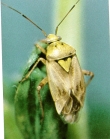
Immature lygus bugs are smooth, shiny-green insects, similar in size to aphids, which move rapidly when disturbed. Adult lygus bugs are small, brown to green with piercing-sucking mouthparts and a white "V" on the back. Lygus bugs inject a toxin during feeding. The toxin kills the area fed upon or causes distorted growth. Damage is most severe on field margins. Highest lygus bug populations develop in alfalfa. Migration into potatoes occurs when alfalfa fields are cut.
False Chinch Bug
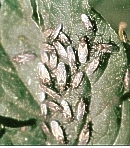
The false chinch bug is less than 1/16 inch long, black with white wings and has a triangular black patch in the middle of the outer margins with red legs. Adults become active in early spring, feeding on various weeds. Populations mass at the top of the plant and wilt or kill the leaves. A wide variety of weed hosts, such as kochias and mustards, are preferred but migration to potatoes may occur when hosts mature.
Integrated Management
Control populations only when these insects are so abundant as to potentially affect yield. Infestations of false chinch bug, in particular, tend to be patchy in occurrence within a field so spot treatments are most appropriate. Common insecticides for potatoes can kill natural enemies as well as insect pests. Protect natural enemies that generally keep these pests under control.
Impact
Variegated cutworm, Peridtroma saucia, is the a common cutworm species in the San Luis Valley. Cabbage loopers, Trichoplusia ni., also are a common pest of vegetables, including lettuce and potato, and flowers. Armyworms, Pseudaletia utziputicta, can occasionally cause severe damage to crops throughout the San Luis Valley. This insect prefers grasses, notably small grains, but will feed on some broadleaf crops such as potatoes after grain matures.
Description and Symptoms
Cutworms
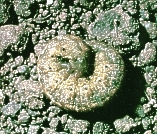
Cutworms feed at night. During the day they can be found under clods of soil or in cracks in the ground near injured plants. Cutworms have a smooth appearance, three pairs of legs and five pairs of prolegs. Damage early in the season includes stems cut off at or below ground level. Later, chewed foliage is the most common symptom. Tubers that are exposed on the surface or in cracks in the soil can be chewed by some cutworms. Cutworms overwinter as immature larvae or eggs in the soil.
Loopers
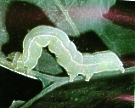
Loopers have green bodies that taper to the head with a white line on each side and two white lines down the back with three pairs of prolegs. Irregular cut holes in the leaves is typical looper damage. Loopers will never damage tubers and rarely eat enough foliage to be significant. Control is rarely needed.
Armyworms

Mature larvae are about 1 1/2 inches in length, smooth-bodied, and dark grey to greenish-black in color. They are characterized by five stripes, three on the back and two on the sides, running the length of the body. The stripes on the sides are pale orange with a white outline. The head capsule is remarkable for its honeycomb of black markings. Dense grass is preferred for egg laying. Armyworm problems in potatoes originate from these sites. Larvae feed at night and on cloudy days, and hide under crop debris during sunny periods. Armyworm damage to leaves usually is restricted to field edges bordering small grains.
Integrated Management
Control weeds to prevent fall egg laying by cutworms. Control cutworms, armyworms and loopers only when scouting indicates a potentially damaging infestation. Pesticide applications to control armyworms usually can be restricted to field edges. Treat infested areas in a specific field using appropriate insecticides when control is necessary. Late season scouting and control is the most important for some varieties. Varieties like Norkotah and reds with tubers near the surface can sustain significant tuber damage. Control worms if 1 per square foot is found. Shaking the foliage and examining the ground is an effective late season scouting method.
Impact
The potato flea beetle is one of the first insect pests to attack young potatoes, but is rarely a serious pest. Injury by flea beetle is caused primarily by adult feeding.
Description and Symptoms
The adults are small dull-black beetles, about 1/16 inch long, with hind legs specially adapted for jumping. A beetle that looks like a pigweed seed and jumps away when examined is probably a flea beetle. Potato flea beetle overwinter as adults in the soil. Adults feed on both leaf surfaces, but usually the underside. They chew small (1/16 inch) circular holes in the leaf. The feeding has a shotgun appearance. Tuber injury can be significant. Usually just an early season pest.
Integrated Management
Scout fields with a sweep net. Control flea beetles when levels reach 200 per 100 sweeps. Thresholds are rarely reached. Control only when thresholds are reached with insecticides.